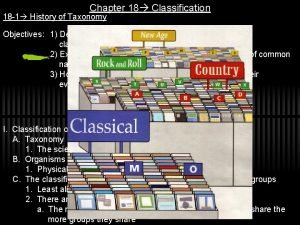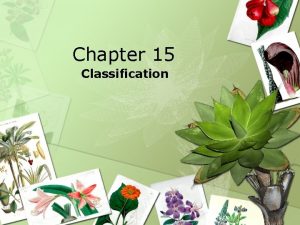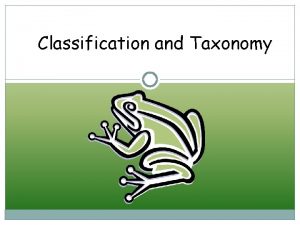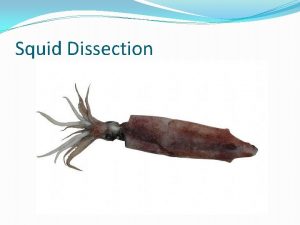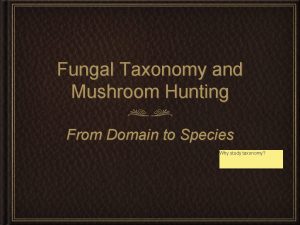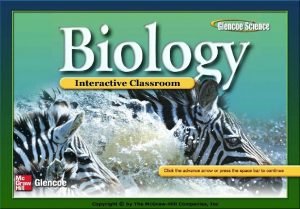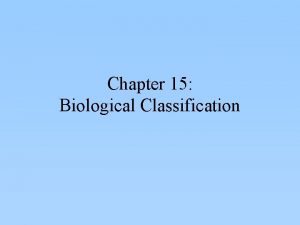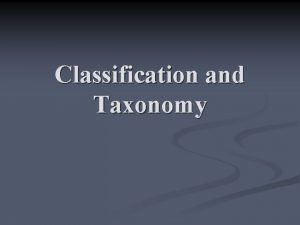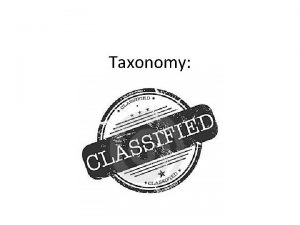Chapter 18 Classification 18 1 History of Taxonomy










- Slides: 10

Chapter 18 Classification 18 -1 History of Taxonomy Objectives: 1) Describe the system scientists use to classify organisms 2) Explain why scientists use scientific names instead of common names 3) How does the classification of living things reflect their evolutionary history? I. Classification of living things A. Taxonomy 1. The science of classifying living things B. Organisms are classified by similarities 1. Physical char. , cell #, cell structure, nutrition C. The classification system is based on a hierarchial system of groups 1. Least alike or similar to most alike or similar 2. There are 8 levels a. The more similar/alike or the more characteristics they share the more groups they share

D. The levels Domain Kingdom Phylum Class Order Family Genus Species 1. 2. 3. 4. 5. 6. 7. 8. Dumb Kids Playing Catch On Freeway Get Squashed Least similar/Alike Most similar/Alike Smallest or most similar/alike group is the species Similar species are collected into a genus Similar genera are collected into a family Similar families are collected into an order Similar orders are collected into a class Similar classes are collected into a phylum Similar phylum are collected into a kingdom Similar kingdoms are collected into a domain

II. What is the scientific name? A. A unique 2 word name that is assigned to each kind of organism 1. Binomial Nomenclature 2. Written in the language of Latin B. What is in a scientific name? 1. The first word is the genus to which the organism belongs a. Describes the organism in a general way 1. Like your first name b. A group of organisms that share major characteristics 2. The second word is the species and identifies one particular kind of organism C. The rules to scientific naming 1. 2 different organisms cannot be assigned the same name 4. Writing a scientific name a. Genus is capitalized b. Species is lowercase c. Both words italicized or underlined Canus lupis Homo sapiens

D. Who was the genius that came up with binomial nomenclature? 1. Carl Linnaeus III. The importance of scientific names A. Common names 1. The name that is used for a particular organism by common every day people a. In other words, the name used outside the field of science 2. Too confusing a. An organism can have more than one common name b. One common name often refers to more than one kind of living thing c. Add to this the variety of languages throughout the world

B. The scientific name 1. Eliminates the confusion 2. Scientific names are recognized and have only one meaning no matter where you go in the world C. Show Evolutionary History 1. Phylogeny IV. What is a species? A. A group of structurally similar organisms that can produce fertile offspring in nature 1. A unique kind of organism 2. Share at least one inherited characteristic not found in other similar organisms B. Hybrids 1. Offspring from different species that are generally sterile 2. May be fertile a. Coyotes, dogs, wolves are all separate species in the same genus that can interbreed creating fertile offspring

18 -2 Modern Phylogenetic Taxonomy I. Systematics A. Branch of biology that classifies organisms based on their phylogeny 1. Organizes diversity of living things in the context of evolution B. Phylogenetic tree 1. Family tree showing evolutionary relationship btwn groups of organisms a. Represents a hypothesis C. Evidence 1. Fossil record 2. Morphology 3. Embryology 4. Chromosomes & macromolecules a. AA sequence comparison

18 -3 Two Modern Systems of Classification Objectives: 1) Differentiate between the six kingdoms of organisms. 2) Identify 2 characteristics of members in each of the six kingdoms. I. The six kingdom classification system A. Eubacteria & Archaebacteria 1. Unicellular 2. Prokaryotic 3. Heterotrophic and autotrophic (photosynthesis) 4. The oldest forms of life

B. Protista 1. Unicellular and Multicellular 2. Eukaryotic 3. Heterotrophic and autotrophic 4. Examples a. Algae (kelps), slime molds, water molds C. Fungi 1. Multicellular 2. Eukaryotic 3. Heterotrophic a. Absorb food 4. Examples a. Molds, mushrooms, yeast

D. Plantae 1. Multicellular 2. Eukaryotic 3. Autotrophic a. Chlorophyll 4. Examples a. Trees, grass, shrubs E. Animalia 1. Multicellular 2. Eukaryotic 3. Heterotrophic a. Digest food II. Characteristics of Life A. Composed of cells B. Organization 1. All living things are highly organized at both the molecular and cellular level C. Energy use 1. All living things must use energy through a process called metabolism

D. Homeostasis 1. All organisms maintain homeostasis E. Reproduction 1. All living things must develop and reproduce
 Kendall and marzano new taxonomy example
Kendall and marzano new taxonomy example Section 18-1 review history of taxonomy
Section 18-1 review history of taxonomy History of taxonomy
History of taxonomy Broadest level of classification
Broadest level of classification Dichotomous key for fungi
Dichotomous key for fungi Phylum of horse
Phylum of horse Dichotomous key animals
Dichotomous key animals Squid taxonomy classification
Squid taxonomy classification Taxonomy of mushroom
Taxonomy of mushroom Organizing lifes diversity
Organizing lifes diversity Taxonomy worksheet chapter 15 answer key
Taxonomy worksheet chapter 15 answer key

